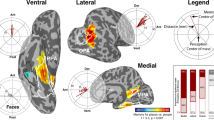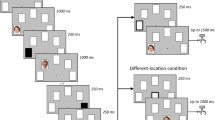Abstract
Using previously published functional magnetic resonance imaging work studying object recall as a framework, we describe the spatial and temporal properties of brain activation as one plausible model of visually triggered access to semantic memory. We suggest that interactions between the dorsomedial thalamus and Brodmann area 6 facilitate the setting of object search criteria and perhaps drive the search. The pulvinar nucleus of the thalamus, in concert with ventral temporal and occipital cortical regions, become active later, perhaps when the criteria are met or the target object is identified.
Similar content being viewed by others
References and Recommended Reading
Damasio H, Grabowski TJ, Tranel D, et al.: A neural basis for lexical retrieval. Nature 1996, 380:499–505.
Martin A, Wiggs CL, Ungerleider LG, Haxby JV: Neural correlates of category-specific knowledge. Nature 1996, 379:649–652.
Hart J, Gordon B: Neural subsystems for object knowledge. Nature 1992, 359:60–64.
Kraut MA, Kremen S, Segal JB, et al.: Object activation from features in the semantic system. J Cogn Neurosci 2002, 14:24–36.
Kraut MA, Kremen S, Moo LR, et al.: Object activation in semantic memory from visual multimodal feature input. J Cogn Neurosci 2002, 14:37–47.
Underwood G, Whitfield A: Right hemisphere interactions in picture-word processing. Brain Cognition 1985, 4:273–286.
Singer W: Synchronization of cortical activity and its putative role in information processing and learning. Annu Rev Physiol 1993, 55:349–374.
Slotnick S, Moo L, Kraut M, et al.: Thalamic modulation of cortical rhythms during semantic memory recall in humans. Proc Natl Acad Sci U S A 2002, 99:6440–6443. This paper is a key article in the organization of semantic memory and/or the thalamus’ plausible role in cognition.
Singer W, Gray CM: Visual feature integration and the temporal correlation hypothesis. Annu Rev Neurosci 1995, 18:555–586.
Klimesch W: Memory processes, brain oscillations and EEG synchronization. Int J Psychophysiol 1996, 24:61–100.
Steriade M: Corticothalamic resonance, states of vigilance and mentation. Neuroscience 2000, 101:243–276. This paper is a key article in the organization of semantic memory and/or the thalamus’ plausible role in cognition.
Gutierrez C, Cola MG, Seltzer B, Cusick C: Neurochemical and connectional organization of the dorsal pulvinar complex in monkeys. J Comp Neurol 2000, 419:61–86.
Ilinsky IA, Jouandet ML, Goldman-Rakic PS: Organization of the nigrothalamocortical system in the rhesus monkey. J Comp Neurol 1985, 236:315–330.
Inase M, Tokuno H, Nambu A, et al.: Origin of thalamocortical projections to the presupplementary motor area (pre-SMA) in the macaque. Neurosci Res 1996, 25:217–227.
Preuss TM, Goldman-Rakic PS: Crossed corticothalamic and thalamocortical connections of macaque prefrontal cortex. J Comp Neurol 1987, 257:269–281.
Yeterian EH, Pandya DN: Corticothalamic connections of paralimbic regions in the rhesus monkey. J Comp Neurol 1988, 269:130–146.
Wilson FA, Scalaidhe SP, Goldman-Rakic PS: Dissociation of object and spatial processing domains in primate prefrontal cortex. Science 1993, 260:1955–1958.
Crosson B, Sadek JR, Bobholz JA, et al.: Activity in the paracingulate and cingulate sulci during word generation: an fMRI study of functional anatomy. Cerebral Cortex 1999, 9:307–316.
Thompson-Schill S, D’Esposito M, Aguirre G, Farah M: Role of left inferior prefrontal cortex in retrieval of semantic knowledge: a reevaluation. Proc Natl Acad Sci U S A 1997, 94:14792–14797.
Nadeau SE, Crosson B: Subcortical aphasia. Brain Lang 1997, 58:355–402.
Hart J, Moo L, Segal JB, et al.: Neural substrates of semantics. In Handbook of Language Disorders. Edited by Hillis A. Philadelphia: Psychology Press; 2002.
Kraut M, Calhoun V, Pitcock JA, et al.: Neural hybrid model of semantic object memory: implications from event-related timing using fMRI. J Int Neuropsychol Soc 2003, 9:1031–1040. This paper is a key article in the organization of semantic memory and/or the thalamus’ plausible role in cognition.
Devlin JT, Russell RP, Davis MH, et al.: Is there an anatomical basis for category-specificity? Semantic memory studies in PET and fMRI. Neuropsychologia 2002, 40:54–75.
Moore CJ, Price CJ: A functional neuroimaging study of the variables that generate category-specific object processing differences. Brain 1999, 122:943–962.
Kraut M, Moo L, Segal J, Hart J: Neural activation during an explicit categorization task: category- or feature-specific effects? Brain Res Cogn Brain Res 2002, 13:213–220.
Caramazza A, Shelton JR: Domain-specific knowledge systems in the brain the animate-inanimate distinction. J Cogn Neurosci 1998, 10:1–34.
Haxby J, Gobbini MI, Furey ML, et al.: Distributed and overlapping representations of faces and objects in ventral temporal cortex. Science 2001, 293:2405–2407. This paper is a key article in the organization of semantic memory and/or the thalamus’ plausible role in cognition.
Miceli G, Fouch E, Capasso R, et al.: The dissociation of color from form and function knowledge. Nature Neurosci 2001, 4:662–667.
Binder JR, Swanson SJ, Hammeke T, et al.: Determination of language dominance using functional MRI: a comparison with the Wada test. Neurology 1996, 46:978–984.
Fiez JA: Phonology, semantics, and the role of the left inferior prefrontal cortex. Hum Brain Mapp 1997, 5:79–83.
Kemmerer D, Tranel D: Verb retrieval in brain-damaged subjects: 1. Analysis of stimulus, lexical, and conceptual factors. Brain Lang 2000, 73:347–392.
Thompson-Schill S, Swick D, Farah M, et al.: Verb generation in patients with focal frontal lesions: a neuropsychological test of neuroimaging findings. Proc Natl Acad Sci U S A 1998, 95:15855–15860.
Ojemann J, Ojemann G, Lettich E: Cortical stimulation mapping of language cortex by using a verb generation task: effects of learning and comparison to mapping based on object naming. J Neurosurg 2002, 97:33–38.
Hart J, Gordon B: Delineation of single-word semantic comprehension deficits in aphasia, with anatomical correlation. Ann Neurol 1990, 27:226–231.
Beauchamp MS, Lee KE, Argall BD, Martin A: Integration of auditory and visual information about objects in superior temporal sulcus. Neuron 2004, 41:809–823.
Vandenberghe R, Price C, Wise R, et al.: Functional anatomy of a common semantic system for words and pictures. Nature 1996, 383:254–256.
Gainotti G: What the locus of brain lesion tells us about the nature of the cognitive defect underlying category-specific disorders: a review. Cortex 2000, 36:539–559.
Tyler L, Moss H: Towards a distributed account of conceptual knowledge. Trends Cogn Sci 2001, 5:244–252. This paper is a key article in the organization of semantic memory and/or the thalamus’ plausible role in cognition.
Warrington E, McCarthy RA: Multiple meaning systems in the brain: a case for visual semantics. Neuropsychologia 1994, 32:1465–1473.
Author information
Authors and Affiliations
Rights and permissions
About this article
Cite this article
Kraut, M.A., Pitcock, J. & Hart, J. Neural mechanisms of semantic memory. Curr Neurol Neurosci Rep 4, 461–465 (2004). https://doi.org/10.1007/s11910-004-0069-6
Issue Date:
DOI: https://doi.org/10.1007/s11910-004-0069-6




